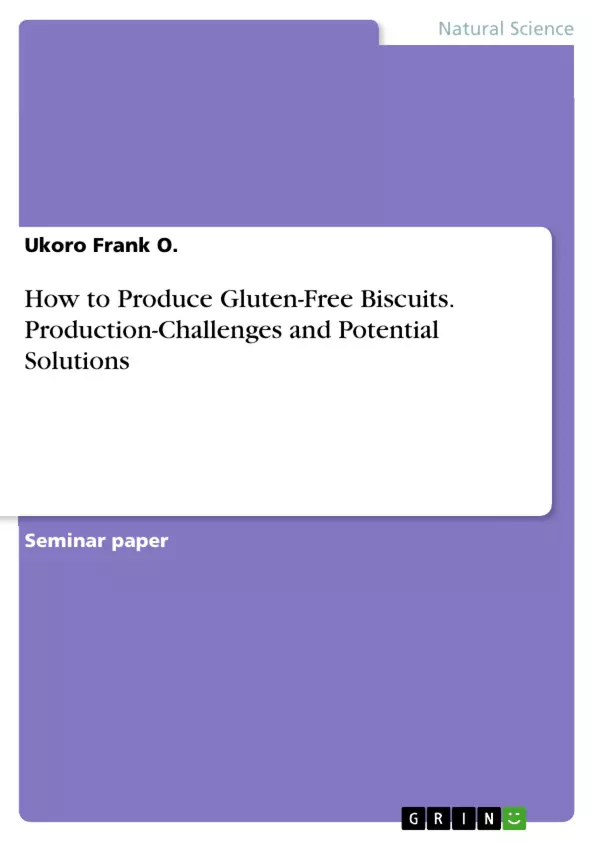This essay examines the challenges of producing gluten-free baked products and gives an overview of how these challenges can be properly addressed.
In the course of this essay, therefore, the specific challenges such a as a weak structure, molding problems, production costs, and low nutrition in general are focused on in more detail. Some potential solutions to these problemes, which are worked out in this work, including extrusion-cooking processes, more temperature control and bio processing fermentation are also shed light on.
The work closes with a few remarks and recommodations on future research in that field of study.
Inhaltsverzeichnis (Table of Contents)
- CHAPTER ONE: INTRODUCTION
- 1.1 OBJECTIVE OF THE STUDY
- CHAPTER TWO LITERATURE REVIEW
- 2.1 GLUTEN
- 2.2 CELIAC DISEASE
- 2.2.1 Symptoms of CD
- 2.2.2 Diagnosis of CD
- 2.3 GLUTEN FREE FOOD
- 2.2.1 Major examples of Gluten Free foods
- 2.4 PROBLEMS ASSOCIATED WITH PRODUCTION
- 2.4.1 Weak structure
- 2.4.2 Molding Problem
- 2.4.4 The production costs
- 2.4.5 Low nutrition in certain ingredient
- 2.5 SOLUTIONS TO THE PROBLEMS RELATED WITH THE PRODUCTION OF GF BAKED FOODS
- 2.5.1 Weak Structure
- 2.5.2 Low nutrition in certain ingredient
- 2.5.3 Production Costs Problem
- 2.5.4 Low nutrition in certain ingredient
- 2.5 OTHER NOVEL TECHNOLOGIES APPROACH FOR IMPROVING GLUTEN FREE BAKED PRODUCT
- 2.5.1 Extrusion-cooking processes
- 2.5.2 Temperature control
- 2.5.3 Bioprocessing fermentation
- CHAPTER THREE: CONCLUSION AND RECOMMENDATION
- 3.1 CONCLUSION
- 3.2 RECOMMENDATION
- REFERENCES
- The role of gluten in traditional baking processes.
- The impact of gluten on individuals with celiac disease and other gluten-related health conditions.
- The challenges associated with producing gluten-free baked goods, including weak structure, molding issues, high production costs, and nutritional deficiencies.
- Potential solutions to improve the quality of gluten-free baked goods, such as the use of functional ingredients, additives, and novel technologies.
- The importance of developing innovative approaches to meet the increasing demand for gluten-free products.
Zielsetzung und Themenschwerpunkte (Objectives and Key Themes)
This study focuses on the challenges associated with producing gluten-free baked goods and explores potential solutions for improving their quality. The study delves into the characteristics of gluten and its impact on traditional baking processes. It also examines the health concerns related to gluten, including celiac disease, and the growing demand for gluten-free products.
Zusammenfassung der Kapitel (Chapter Summaries)
Chapter One provides an overview of the study's objectives and introduces the critical role of gluten in traditional bakery products. It also highlights the health concerns associated with gluten consumption and the rising demand for gluten-free alternatives.
Chapter Two reviews the literature on gluten, celiac disease, gluten-free food products, and the challenges and solutions associated with their production. The chapter delves into the specific problems related to gluten-free baking, including weak structure, molding, high production costs, and nutritional deficiencies. It also explores potential solutions, such as incorporating functional ingredients, additives, and novel technologies like extrusion-cooking processes, temperature control, and bioprocessing fermentation.
Schlüsselwörter (Keywords)
Gluten-free, gluten, celiac disease, baking, food science, functional ingredients, additives, extrusion-cooking, temperature control, bioprocessing fermentation, food technology.
- Quote paper
- Ukoro Frank O. (Author), 2018, How to Produce Gluten-Free Biscuits. Production-Challenges and Potential Solutions, Munich, GRIN Verlag, https://www.hausarbeiten.de/document/507417


